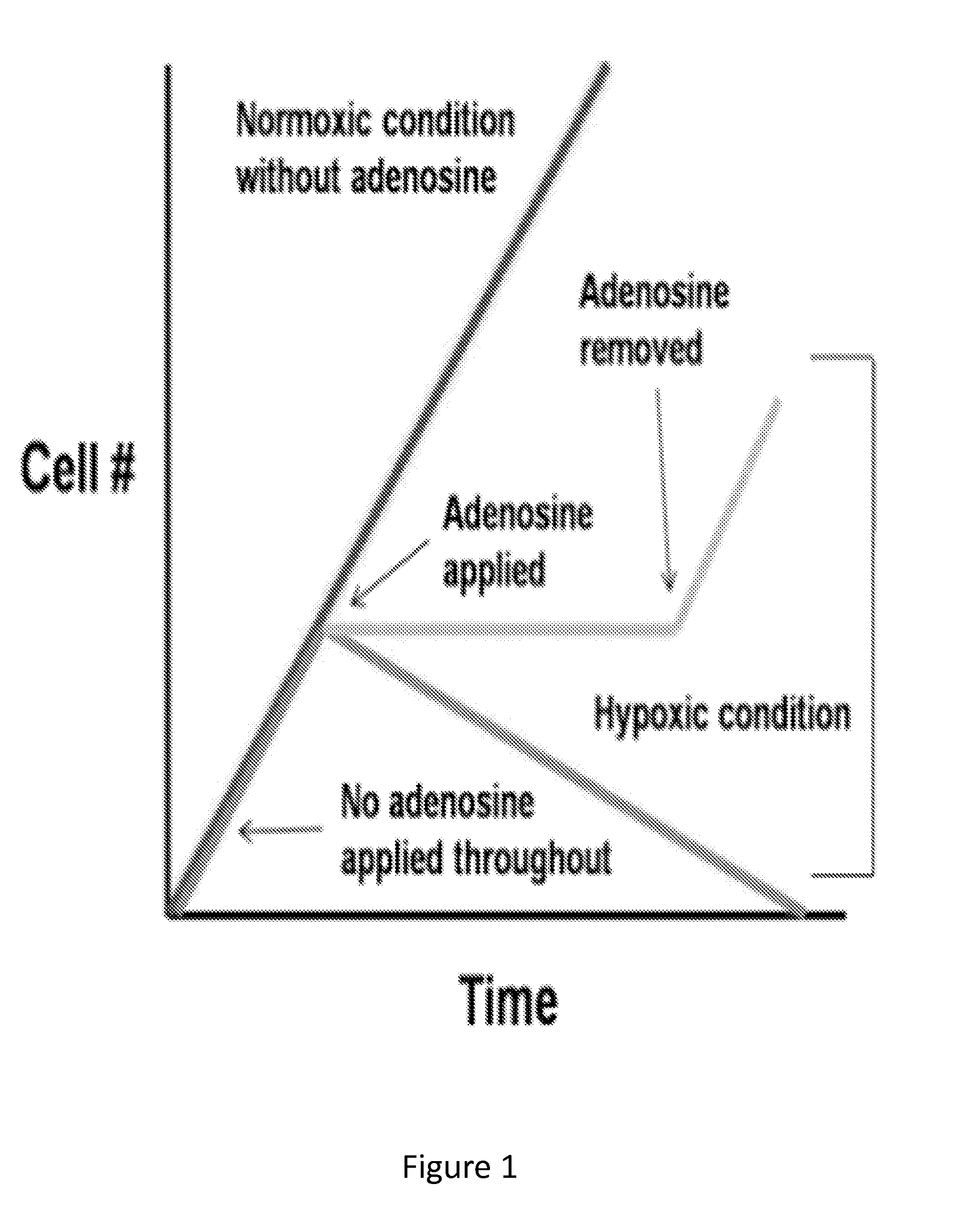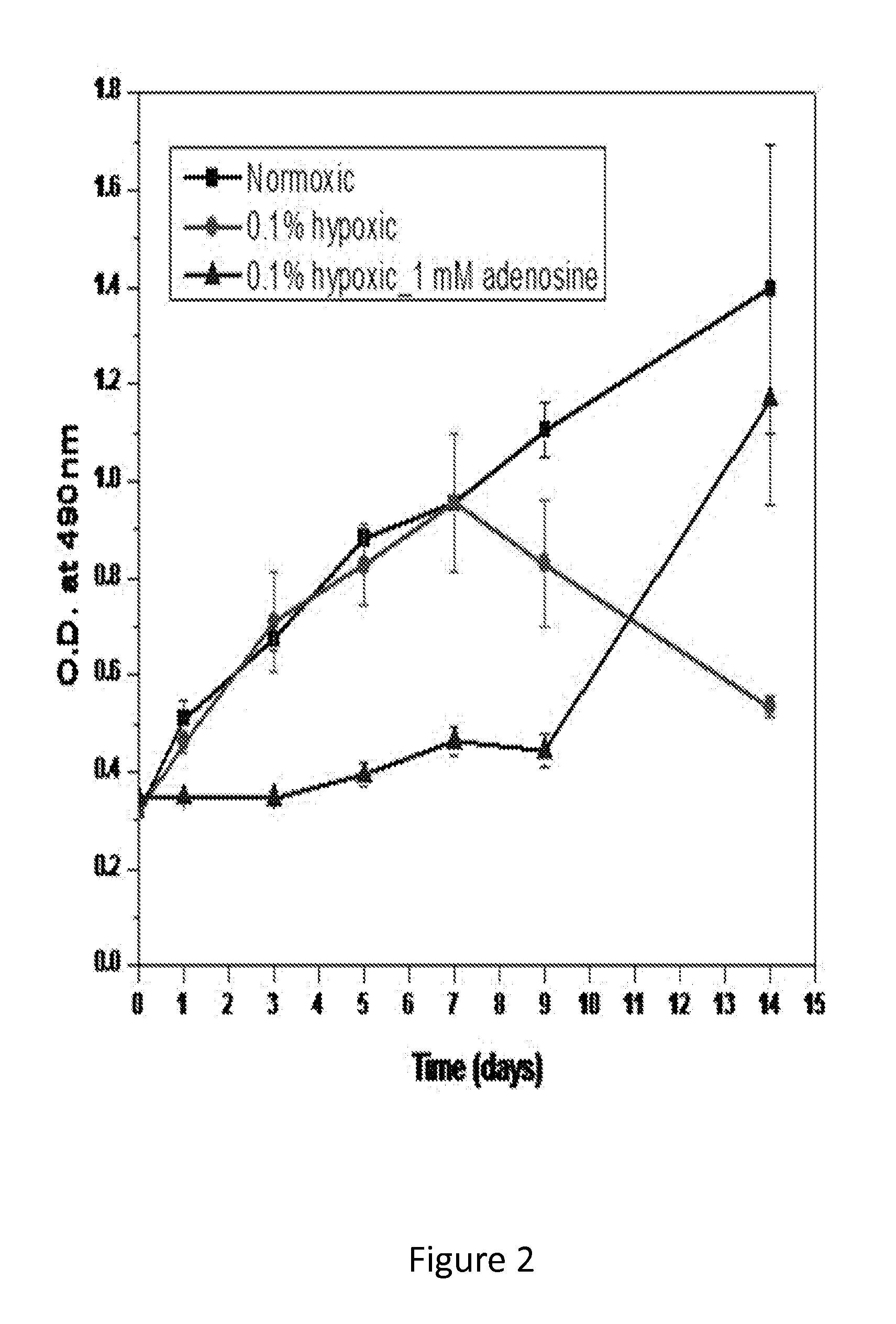Metabolic downregulation for cell survival
a cell survival and metabolic technology, applied in the field of metabolic downregulation for cell survival, can solve the problems of preventing the diffusion of oxygen into the interior of the scaffold, vascularization of implanted tissues, and imposing immediate oxygen supply limits, so as to increase the viability of the cell and reduce the oxygen demand of the cell
- Summary
- Abstract
- Description
- Claims
- Application Information
AI Technical Summary
Benefits of technology
Problems solved by technology
Method used
Image
Examples
example 1
Effect of Adenosine and its Characterization on Cellular Activity
[0098]The following studies were performed to evaluate whether: 1) hypoxic cells not treated with adenosine result in necrosis; 2) cells under hypoxic condition maintain a steady state of metabolic activity when treated with adenosine; and 3) hypoxic cells resume their normal proliferation rate when the effects of adenosine is removed.
[0099]500 μL of a cell suspension (C2C12 cells, murine myoblasts) in high glucose Dulbecco's modified Eagle's medium (DMEM, Gibco) containing 10% FBS, 500 U / mL penicillin and 500 μg / mL streptomycin was placed in each well of a 48-well culture plate at a density of 1052 (FIG. 2) and 2105 (FIG. 3) cells / cm2. Cells were incubated for 24 hr in normoxic conditions (21% O2, 37° C.) prior to placement in a hypoxic chamber. At day 0, the plates designated as the hypoxic group were transferred to the hypoxic chamber (0.1% O2). A group with no adenosine was placed under hypoxia for up to 13 days to...
example 2
The Effect of Adenosine Derivatives on In Vitro Cell Survival
[0104]Three known ADA inhibitors were examined to evaluate the efficacies of adenosine derivatives: cladribine, pentostatin, and fludarabine phosphate. They have similar structures and molecular weights compared to adenosine, but different functional groups in the structures. Metabolic rate of cells were indirectly analyzed by cell viability in the presence or absence of adenosine derivatives and ADA in various doses. Cell viability with the drugs was evaluated under normoxic conditions.
[0105]Adenosine was converted and lost its activity in presence of ADA. Among the adenosine derivatives tested, cladribine was best able to inhibit ADA and depress the cells' metabolic rate (FIG. 6). When the drugs were removed on day 5, cells recovered their relatively normal metabolic state and increased proliferation compared to non-treated cells in all groups (FIG. 7A-7E).
[0106]Among the adenosine derivatives tested, cladribine showed t...
example 3
Protection Against Ischemic Injury by Metabolic Downregulation
[0107]The effect of cladribine (CDA) on tissue survival were evaluated using the following two ischemic animal models. CDA, an adenosine derivative, was used for in vivo studies as it is more stable than adenosine in the presence of adenosine degrading enzymes.
[0108]Skin flap model: The u-shaped skin flaps were created on the back of the nude mice, then silicone sheet with 100 mM CDA-containing 2% agarose gel on top of it was placed subcutaneously between muscle and skin layer (FIGS. 9A-9B). Control group received only the materials without CDA incorporated (n=3 per each group). At day 3, the flap necrosis was photographed, and H&E sections were prepared and microscopically examined.
[0109]Compartment syndrome model: Neonatal blood pressure cuffs were placed on the hind limbs of Sprague Dawley rats. A pressure of 130-140 mmHg was held for 3 hrs to induce compartment syndrome in the tibialis anterior (TA) muscle. The experi...
PUM
| Property | Measurement | Unit |
|---|---|---|
| Basal metabolic rate (total) | aaaaa | aaaaa |
| Cell viability | aaaaa | aaaaa |
Abstract
Description
Claims
Application Information
 Login to View More
Login to View More - R&D
- Intellectual Property
- Life Sciences
- Materials
- Tech Scout
- Unparalleled Data Quality
- Higher Quality Content
- 60% Fewer Hallucinations
Browse by: Latest US Patents, China's latest patents, Technical Efficacy Thesaurus, Application Domain, Technology Topic, Popular Technical Reports.
© 2025 PatSnap. All rights reserved.Legal|Privacy policy|Modern Slavery Act Transparency Statement|Sitemap|About US| Contact US: help@patsnap.com



